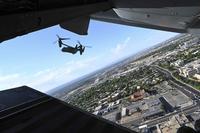
From this morning's front page at Military.com.
The threat from an adversary's use of space is more than just zapping a satellite out of sky. It could be as mundane as grabbing an up-to-date reconnaissance image from a free Web site.
That's a scenario a top Air Force official is trying to counter as more countries push their own commercial payloads into the highest frontier. With the easy access to free online imagery services such as Google Earth and Yahoo Maps, and other paid sites, military officials are worried an enemy might gain vital intelligence on U.S. and allied military positions anonymously and with little investment.
"It could be as simple as how is it that an adversary gets an image off of Google Earth that could somehow threaten American lives or interests," said Lt. Gen. Michael Hamel, who manages space and missile systems development for the Air Force. "That is an example of a space threat that we may face in the future,"
Hamel told Military reporters at a March 11 breakfast meeting in Washington he is pressuring domestic licensing authorities to force satellite imagery providers to reduce the resolution of their images in areas where American troops are engaged, or to delay their image feed so that an adversary can't get up-to-the-minute information on U.S. and allied military moves.
Most free online imaging tools block the resolution of their satellite photos in sensitive regions, though sometimes detailed information does slip through. On March 7, the head of the Northern Command banned Google Earth photo teams from U.S. military installations after one group shot panoramic images of Fort Sam Houston in Texas for the company's "Street View" component.
Google officials quickly pulled the images from its Google Earth site and apologized for the incident, saying it wasn't their policy to photo military bases.
That's the kind of slip up that worries space managers like Hamel.
"We want our aerospace industry to be at the cutting edge of commercial providers" for imagery, Hamel explained. "We also want to make sure that the kind of information that can get out into the public domain and used is not going to threaten our legitimate security interests."
"We'd like to have U.S. companies that are at the forefront of this such that we could ... ensure that there is not data of greater currency than what we believe would be militarily acceptable.
But international commercial operators who aren't beholden to any U.S. laws might balk at protecting America's security interests in the face of cold hard cash. So Hamel hopes to either beat them into space and edge them out of the neighborhood, or cajole them into sticking to the American licensing standards.
"It's part of our national interest to ensure that we set the conditions not only for U.S. companies but also set some of the norms in terms of how systems on an international or allied basis are used," he added.
Though U.S. officials and military brass can try to strong-arm other countries into going America's way, the rapid increase in demand for information that was once the only accessible by governments and the tools to deliver that data means the risk will only increase.
"We're seeing a significant growth in both civil and commercial remote sensing capabilities ... in this country and with friends and in various other nations are actively developing and fielding capabilities," Hamel said. "It wasn't too many years ago that what would have been our cutting edge reconnaissance capability, now are commercially purchasable products.
-- Christian








